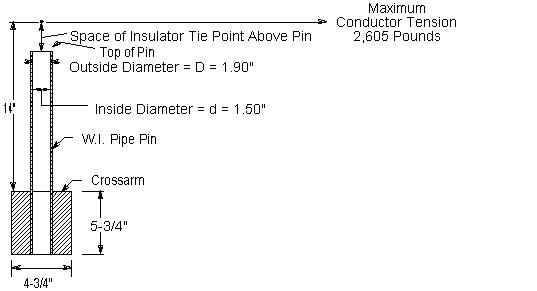Ties used in connection with pin–type insulators shall conform to Rule 49.3. In this problem a No. 4 and No. 8 annealed copper wire are used for the No. 00 and No. 8 circuits involved.
Pins used in connection with pin–type insulators shall have sufficient strength to withstand the tension in the conductor. In the case under discussion wrought iron pipe–pins of the dimensions and construction indicated below are to be employed for the power conductors.

Bending moment (at crossarm) M = 2,605 x 14 = 36,470 pound–inches
![]()

Assuming that the ultimate fiber stress of wrought iron is 48,000 pounds per square inch, a single pin is not sufficient, as it provides a safety factor of 0.542,
![]()
for an assumed tension of 2,605 pounds in the conductor at maximum loading. Since a safety factor of unity (Rule 47.5 ) is required, two pins are necessary and therefore double crossarms, pins and insulators are used on the poles supporting the crossing span.
Locust pins are to be used in this case for the private telephone conductors. Although a 1–1/2 inch locust pin would be sufficient to withstand the conductor tension of 570 pounds with a safety factor of at least unity, as required by Rule 47.4 , care would be necessary to provide sufficient strength in the conductor fastenings. In this problem, the private telephone conductors are considered to be dead–ended at the ends of the crossing span.